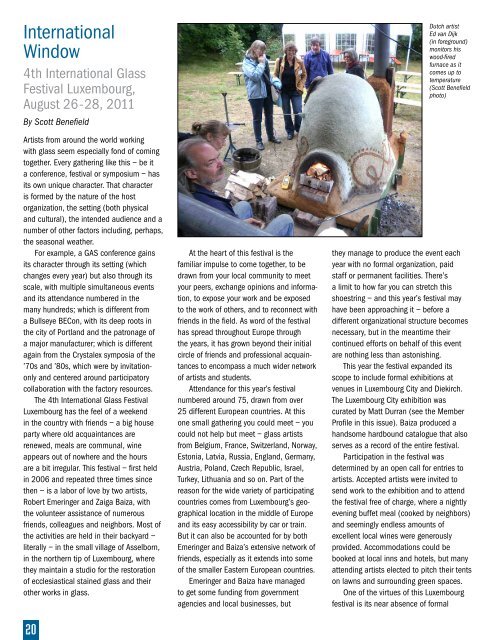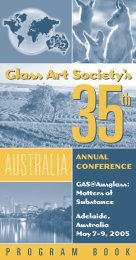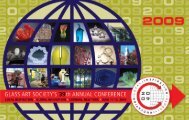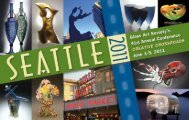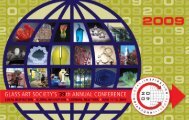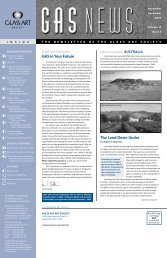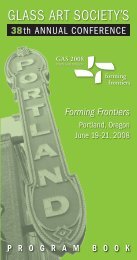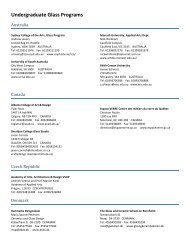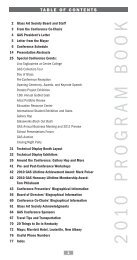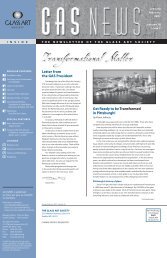GASNews October/ November 2011 Volume 22 ... - Glass Art Society
GASNews October/ November 2011 Volume 22 ... - Glass Art Society
GASNews October/ November 2011 Volume 22 ... - Glass Art Society
Create successful ePaper yourself
Turn your PDF publications into a flip-book with our unique Google optimized e-Paper software.
International<br />
Window<br />
4th International <strong>Glass</strong><br />
Festival Luxembourg,<br />
August 26-28, <strong>2011</strong><br />
By Scott Benefield<br />
<strong>Art</strong>ists from around the world working<br />
with glass seem especially fond of coming<br />
together. Every gathering like this – be it<br />
a conference, festival or symposium – has<br />
its own unique character. That character<br />
is formed by the nature of the host<br />
organization, the setting (both physical<br />
and cultural), the intended audience and a<br />
number of other factors including, perhaps,<br />
the seasonal weather.<br />
For example, a GAS conference gains<br />
its character through its setting (which<br />
changes every year) but also through its<br />
scale, with multiple simultaneous events<br />
and its attendance numbered in the<br />
many hundreds; which is different from<br />
a Bullseye BECon, with its deep roots in<br />
the city of Portland and the patronage of<br />
a major manufacturer; which is different<br />
again from the Crystalex symposia of the<br />
’70s and ’80s, which were by invitationonly<br />
and centered around participatory<br />
collaboration with the factory resources.<br />
The 4th International <strong>Glass</strong> Festival<br />
Luxembourg has the feel of a weekend<br />
in the country with friends – a big house<br />
party where old acquaintances are<br />
renewed, meals are communal, wine<br />
appears out of nowhere and the hours<br />
are a bit irregular. This festival – first held<br />
in 2006 and repeated three times since<br />
then – is a labor of love by two artists,<br />
Robert Emeringer and Zaiga Baiza, with<br />
the volunteer assistance of numerous<br />
friends, colleagues and neighbors. Most of<br />
the activities are held in their backyard –<br />
literally – in the small village of Asselborn,<br />
in the northern tip of Luxembourg, where<br />
they maintain a studio for the restoration<br />
of ecclesiastical stained glass and their<br />
other works in glass.<br />
20<br />
At the heart of this festival is the<br />
familiar impulse to come together, to be<br />
drawn from your local community to meet<br />
your peers, exchange opinions and information,<br />
to expose your work and be exposed<br />
to the work of others, and to reconnect with<br />
friends in the field. As word of the festival<br />
has spread throughout Europe through<br />
the years, it has grown beyond their initial<br />
circle of friends and professional acquaintances<br />
to encompass a much wider network<br />
of artists and students.<br />
Attendance for this year’s festival<br />
numbered around 75, drawn from over<br />
25 different European countries. At this<br />
one small gathering you could meet – you<br />
could not help but meet – glass artists<br />
from Belgium, France, Switzerland, Norway,<br />
Estonia, Latvia, Russia, England, Germany,<br />
Austria, Poland, Czech Republic, Israel,<br />
Turkey, Lithuania and so on. Part of the<br />
reason for the wide variety of participating<br />
countries comes from Luxembourg’s geographical<br />
location in the middle of Europe<br />
and its easy accessibility by car or train.<br />
But it can also be accounted for by both<br />
Emeringer and Baiza’s extensive network of<br />
friends, especially as it extends into some<br />
of the smaller Eastern European countries.<br />
Emeringer and Baiza have managed<br />
to get some funding from government<br />
agencies and local businesses, but<br />
Dutch artist<br />
Ed van Dijk<br />
(in foreground)<br />
monitors his<br />
wood-fired<br />
furnace as it<br />
comes up to<br />
temperature<br />
(Scott Benefield<br />
photo)<br />
they manage to produce the event each<br />
year with no formal organization, paid<br />
staff or permanent facilities. There’s<br />
a limit to how far you can stretch this<br />
shoestring – and this year’s festival may<br />
have been approaching it – before a<br />
different organizational structure becomes<br />
necessary, but in the meantime their<br />
continued efforts on behalf of this event<br />
are nothing less than astonishing.<br />
This year the festival expanded its<br />
scope to include formal exhibitions at<br />
venues in Luxembourg City and Diekirch.<br />
The Luxembourg City exhibition was<br />
curated by Matt Durran (see the Member<br />
Profile in this issue). Baiza produced a<br />
handsome hardbound catalogue that also<br />
serves as a record of the entire festival.<br />
Participation in the festival was<br />
determined by an open call for entries to<br />
artists. Accepted artists were invited to<br />
send work to the exhibition and to attend<br />
the festival free of charge, where a nightly<br />
evening buffet meal (cooked by neighbors)<br />
and seemingly endless amounts of<br />
excellent local wines were generously<br />
provided. Accommodations could be<br />
booked at local inns and hotels, but many<br />
attending artists elected to pitch their tents<br />
on lawns and surrounding green spaces.<br />
One of the virtues of this Luxembourg<br />
festival is its near absence of formal


